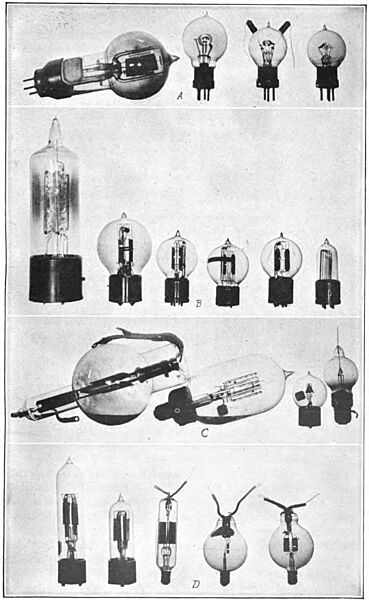Image: Early triode vacuum tubes

Description: The first triode vacuum tubes from around 1918, all derived from the Audion tube, invented by Lee De Forest in 1906. The recognition of the Audion's ability to amplify signals, around 1912, caused its rapid development by several organizations. Bottom row (D): Audions, made by De Forest's company. 3rd row (C): General Electric tubes invented by Irving Langmuir, called "Pliotrons". 2nd row (B): Tubes developed by Western Electric (Bell Telephone Co.) who bought the Audion rights from De Forest; these were used in the first telephone line repeaters which made the first transcontinental telephone service possible in 1915. Top row (A): French tubes. De Forest let his French patent rights to the Audion lapse in 1912 through lack of a $125 filing fee, and the French government manufactured hundreds of thousands of these tubes during World War 1. The triode consists of an evacuated glass bulb with three electrodes inside: a heated filament, a control grid consisting of a screen of wires, and a metal plate. The American tubes (B), (C), and (D) were all constructed with a filament in the center, with the grid consisting of two flat screens on either side, and the plate consisting of two flat metal plates outside that. The French tubes (A) had a horizontal filament wire, surrounded by a grid consisting of a helix of wire, surrounded by a concentric plate consisting of a metal cylinder. The smaller tubes on the right of each row were used in radio receivers, while the larger tubes to the left were higher power types used in transmitters.
Title: Early triode vacuum tubes
Credit: Downloaded July 22,2013 from The Principles Underlying Radio Communication, National Bureau of Standards radio pamphlet no. 40, US Signal Corps. December 10, 1918, US Government Printing Office, p. 321, fig. 250 on Google Books
Author: Unknown authorUnknown author
Usage Terms: Public domain
License: Public domain
Attribution Required?: No
Image usage
The following page links to this image:

